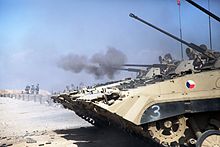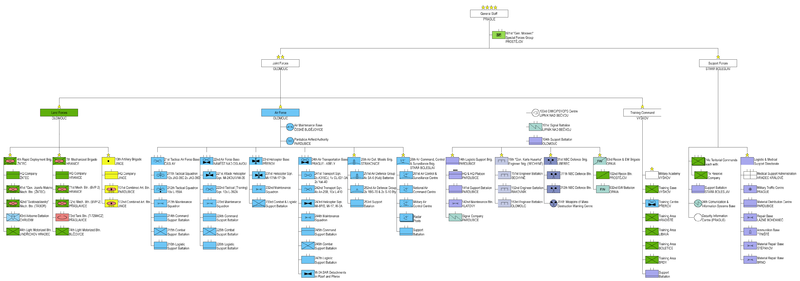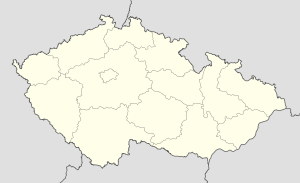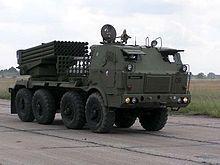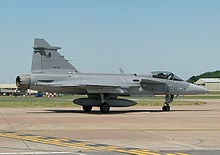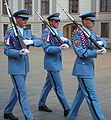- Military of the Czech Republic
-
Military of the Czech Republic
Armáda České republiky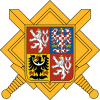

The coat of arms and roundelFounded c.1918 Current form 1993 Service branches Land Forces, Czech Air Force Leadership Commander-in-Chief President of the Republic Václav Klaus Chief of staff Chief of the General Staff: General Vlastimil Picek Manpower Military age 18 years of age Conscription Abolished in 2004 Available for
military service2,414,728, age 15–49 (2005 est.) Fit for
military service1,996,631, age 15–49 (2005 est.) Reaching military
age annually66,583 (2005 est.) Active personnel 23,136 military and 9,017 civilian employees [1] Reserve personnel 1200 [2] Expenditures Budget CZK 48.8 (2010) Percent of GDP 1.32% (2010)[3] Industry Foreign suppliers Russia, United States, Germany The Army of the Czech Republic (Czech: Armáda České republiky) comprise the land forces, the Czech Air Force and support units. From the late 1940s to 1989, the extensive Czechoslovak Armed Forces (about 200,000) formed one of the pillars of the Warsaw Pact military alliance. After the dissolution of Czechoslovakia, the Czech Republic is completing a major reorganisation and reduction of the armed forces, which intensified after the Czech Republic joined NATO on March 12, 1999.
Contents
History
The Czechoslovak Armed Forces were originally formed after 1918. Following the dissolution of Czechoslovakia in 1938, Czechoslovak units and formations served with the Polish Army (Czechoslovak Legion), the French Army, the Royal Air Force, the British Army (the 1st Czechoslovak Armoured Brigade), and the Red Army (I Corps). Four Czech and Slovak-manned RAF squadrons were transferred to Czechoslovak control in late 1945.
From 1945 until 1990, the Army was known as the Czechoslovak People's Army (ČSLA).[4] Although the ČSLA, as formed in 1945, included both Soviet- and British-sponsored expatriate troops, the British-sponsored soldiers had been purged from the ČSLA by 1948. The ČSLA offered no resistance to the invasion mounted by the Soviets in 1968 in reaction to the "Prague Spring", and was extensively reorganized by the Soviets following the re-imposition of communist rule in Prague.
"Of the approximately 201,000 personnel on active duty in the ČSLA in 1987, about 145,000, or about 72 percent, served in the ground forces (commonly referred to as the army). About 100,000 of these were conscripts."[5] There were two military districts, Western and Eastern. A 1989 listing of forces shows two Czech armies in the west, the 1st at Pribram with one tank division and three motor rifle divisions, the 4th at Pisek with two tank divisions and two motor rifle divisions. In the Eastern Military District, there were two tank divisions, the 13th and 14th, with a supervisory headquarters at Trencin in the east of the country.[6]
During the Cold War, the ČSLA was equipped primarily with Soviet arms, although certain arms like the P-27 Panceřovka antitank rocket launcher and the SKOT armored personnel carrier were of Czechoslovak design.
Czech BVP2 firing in Afghanistan
The Army of the Czech Republic was formed after the Czechoslovak Armed Forces split after the 1 January 1993 dissolution of Czechoslovakia. Czech forces stood at 90,000 in 1993. They were reduced to around 65,000 in 11 combat brigades and the Air Force in 1997, to 63,601 in 1999,[7] and to 35,000 in 2005. At the same time, the forces were modernized and reoriented towards a defensive posture. In 2004 the army transformed itself into a fully professional organization and compulsory military service was abolished. The Army maintains an active reserve.
The Czech Republic is a member of the United Nations and the Organization for Security and Co-operation in Europe. Since 1990, the ACR and the Czech Armed Forces have contributed to numerous peacekeeping and humanitarian operations, including IFOR, SFOR, and EUFOR Althea in Bosnia, Desert Shield/Desert Storm, Afghanistan, Kosovo, Albania, Turkey, Pakistan and with the Coalition forces in Iraq.
Current deployments (as of 2010):
- Kosovo: NATO Operation "Joint Enterprise" (KFOR) - 450 soldiers
- Afghanistan: NATO Operation (ISAF) - 458 soldiers, 12 civilian experts and 3 Mi-171S helicopters in Faizabad, Logar and Paktika provinces.
- Somalia: EU Operation Atalanta (NAVFOR) - 3 soldiers
- DR Congo: UN peacekeeping mission (MONUC) - 3 military observers
- Afghanistan: UN peacekeeping mission (UNAMA) - 1 military observer
- Kosovo: UN peacekeeping mission (UNMIK) - 1 military observer
In February 2010 Czech media started to speculate about possible corruption around the purchase of Pandur II vehicles for the Czech Army.[8]
Structure
Structure of the Czech Armed Forces consists of three parts:
- General Staff of Czech Armed Forces (Praha)
 Joint Forces (Olomouc)
Joint Forces (Olomouc) Support and Training Forces (Stará Boleslav)
Support and Training Forces (Stará Boleslav)
Czech Army - combat brigade locations The 153rd Engineer Battalion based in Olomouc was created on 15. October 2008 and is subordinated to the 15th Engineer Brigade, Joint Forces Command. The unit is stationed in the outskirts of the city of Olomouc, in place of the canceled 156th Rescue Battalion.[9]
Active reserves
Active Reserve (in Czech Aktivní záloha) is a part of the otherwise professional Army of the Czech Republic. This service was created to allow participation of citizens with positive attitude to the military.
A volunteer needs either to have completed the compulsory military service (which ended in 2004) or to attend 8 week training. Then the reservists have to serve up to three weeks a year and can be called to serve two weeks in time of non-military crisis. They are not intended to serve abroad. The Reserve presents itself on events like BAHNA, a military show.
Equipment
 Assault rifle Sa vz. 58.
Assault rifle Sa vz. 58.
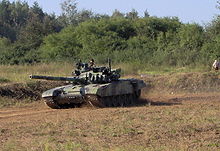 Czech modernized T-72.
Czech modernized T-72.
 Czech BVP-2 on a Military parade in Prague, 28 October 2008.
Czech BVP-2 on a Military parade in Prague, 28 October 2008.
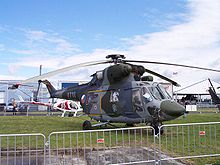 Czech Air Force PZL W-3A
Czech Air Force PZL W-3A
Equipment numbers as of July 1, 2008:[10]
Main battle tanks:
- 30x T-72M4CZ
 Czech Republic
Czech Republic - 149x T-72 MBT (in reserve status)
 Soviet Union
Soviet Union
IFVs and APCs:
- 174x BVP-2 Armoured Infantry Fighting Vehicle
 Soviet Union
Soviet Union - 207x BVP-1 Armoured Infantry Fighting Vehicle
 Soviet Union
Soviet Union - 105x BVP-1 variants: 76x BPzV (Armoured Reconnaissance Vehicle) and 29x OT-90 (APC)
 Czechoslovakia
Czechoslovakia - 28x OT-64 APC
 Czechoslovakia/
Czechoslovakia/ Poland
Poland - 107x Pandur II APC/IFV
 Austria
Austria
Artillery:
- 164x 152mm SpGH DANA Self-propelled Howitzer
 Czechoslovakia
Czechoslovakia - 60x RM-70 122mm Multiple Rocket Launcher
 Czechoslovakia
Czechoslovakia - 85x M1982 PRAM-L 120mm towed mortar
 Czechoslovakia
Czechoslovakia - 8x SPM-85 PRAM-S 120mm self-propelled mortar
 Czechoslovakia
Czechoslovakia - 3x ARTHUR Artillery Tracking Radar
 Sweden
Sweden
Non armoured vehicles:
- 114x Land Rover Defender 110 TDi - light off road vehicle
 United Kingdom
United Kingdom - 79x Land Rover Defender 130 Kajman
 United Kingdom
United Kingdom - 588x Tatra T 810 military trucks
 Czech Republic
Czech Republic - 1,000+x Tatra T815 (4x4, 6x6, 8x8, 10x10 versions) military heavy trucks[11]
 Czech Republic
Czech Republic - 19x Dingo 2 armored military truck
 Germany
Germany - 110x Iveco LMV armored light off road vehicle
 Italy
Italy
Air-defence systems:
- 2K12 Kub-M2 (SA-6 GAINFUL)
 Soviet Union
Soviet Union - 9K35 Strela-10M (SA-13 GOPHER)
 Soviet Union
Soviet Union - 16x RBS 70[11]
 Sweden
Sweden
Combat aircraft and helicopters:
- 14x JAS 39 Gripen fighters
 Sweden
Sweden - 28x Aero L 159 ALCA light attack aircraft
 Czech Republic
Czech Republic - 29x Mil Mi-35 attack helicopters
 Soviet Union/
Soviet Union/ Russia
Russia
Support/transport aircraft and helicopters:
- 10x PZL W-3 Sokół utility helicopters
 Poland
Poland - 16x Mil Mi-17 transport helicopters
 Soviet Union
Soviet Union - 16x Mil Mi-171S transport helicopters
 Russia
Russia - 4x EADS CASA C-295M transport aircraft
 Spain
Spain - 4x Antonov An-26 Curl transport aircraft
 Soviet Union
Soviet Union - 10x Let L-410 Turbolet light transport and photographic mapping
 Czech Republic
Czech Republic - Sojka III unmanned aerial vehicle
Training aircraft and helicopters:
- 8x Aero L-39 Albatros jet trainer
 Czechoslovakia
Czechoslovakia - 8x Zlin Z 142CAF basic trainer
 Czechoslovakia
Czechoslovakia - 5x Mil Mi-2 Hoplite trainer helicopters
 Soviet Union
Soviet Union - 4x Eurostar EV97 basic trainer
 Czech Republic
Czech Republic
VIP transport
- 2x Airbus A319CJW
 France
France - 2x Yakovlev Yak-40 Codling
 Soviet Union
Soviet Union - 1x Bombardier Challenger 600
 Canada
Canada
Small arms & hand weapons:
- M60 machine gun
 United States
United States - M4 carbine
 United States
United States - CZ 805 Bren A1 gradually replaces Vz. 58[12]
 Czech Republic
Czech Republic - Sa vz. 58 standard service rifle, gradually replaced by CZ 805 Bren
 Czechoslovakia
Czechoslovakia - Vz. 52 rifle is used as ceremonial weapon by Prague Castle Guard.
- Škorpion vz. 61 submachine gun
 Czech Republic
Czech Republic - PDW Škorpion EVO III submachine gun
 Czech Republic
Czech Republic - Heckler & Koch MP5 submachine gun
 Germany
Germany - Uk vz. 59 General purpose machine gun
 Czechoslovakia
Czechoslovakia - Sako TRG
 Finland
Finland - Dragunov Sniper Rifle (SVD)
 Soviet Union
Soviet Union - Glock pistol
 Austria
Austria - CZ 700 sniper rifle
 Czech Republic
Czech Republic - CZ 75 pistol
 Czechoslovakia/
Czechoslovakia/ Czech Republic
Czech Republic - CZ-82 pistol Police
 Czechoslovakia/
Czechoslovakia/ Czech Republic
Czech Republic - CZ 97B pistol
 Czech Republic
Czech Republic - CZ 100 pistol
 Czech Republic
Czech Republic - RPG-7V anti-tank grenade launcher
 Soviet Union
Soviet Union - RPG-75 anti-tank weapon
 Czechoslovakia
Czechoslovakia - Carl Gustav M3 recoilless rifle
 Sweden
Sweden - FGM-148 Javelin anti-tank missile launcher
 United States
United States
Uniforms
Different types of Czech Army uniforms:
-
Standard Czech camouflage uniform and vz. 58 standard service rifle
-
Military band Olomouc
-
Soldier of Prague Castle guard holding Vz. 52 rifle
Commanding officers
- Chief of the General Staff: Lieutenant General Vlastimil Picek
- Chief of the General Staff Office: Colonel Milan Šeiner
- First Deputy Chief of the General Staff: Lieutenant General Jaroslav Kolkus
- Deputy Chief of the General Staff of the ACR-Chief of Staff: Lieutenant General František Hrabal
- Deputy Chief of the General Staff - Director of JOC (Operations Commander): Major General Josef Prokš
- Director of Division for Development of Forces Branches - Operations Division: Brigadier General Josef Bečvář
-
- Immediately Subordinated Offices:
- Military Regional Office, Boletice
- Military Regional Office, Brdy
- Military Regional Office, Březina
- Military Regional Office, Hradiště
- Military Regional Office, Libavá
- Support Policy Division: Director Major General Pavel Jevula
- Immediately Subordinated Institutions:
- Central Military Hospital, Prague
- Military Hospital, Brno
- Military Hospital, Olomouc
- Institute of Aviation Medicine, Prague
- Communication and Information Systems Division:Director - Chief of the Signal Corps of ACR: Colonel Jan Kaše
- Immediately Subordinated Institutions:
- 6th Communication Centre
- Research and Communication Centre 080
- Information Technology Development Agency
- Force Planning Division: Acting Director Colonel František Mičánek
- Reconnaissance and Electronic Warfare Department: Director Colonel Miroslav Žižka
- Immediately Subordinated Office:
- Military Geography and Hydrometeorology Office
- Military Aviation Authority: Director Colonel Josef Otta
References
- ^ http://www.army.cz/scripts/detail.php?id=5770
- ^ http://www.acr.army.cz/vycvik-a-nasazeni/aktivni-zalohy/aktuality/alexandr-vondra:-aktivni-zalohu-je-treba-docenit-a-dale-rozvijet-59154/ czech
- ^ http://www.army.cz/scripts/detail.php?id=5760
- ^ For more information on the Czechoslovak Army during the Cold War, see Gordon L. Rottman, Warsaw Pact Ground Forces, Osprey Publishing, 1987
- ^ Library of Congress Country Study: Czechoslovakia, Ground Forces, 1987
- ^ Orbat.com, Warsaw Pact Order of Battle 1989, accessed 2 June 2010
- ^ "Starting points for professionalization of the armed forces" (in Czech). 2000. http://www.defenceandstrategy.eu/filemanager/files/file.php?file=6406. Retrieved 2008-06-27.
- ^ http://zpravy.idnes.cz/secret-pandur-agreement-bring-the-politicians-we-ll-pay-pio-/prilohy.asp?c=A100221_142541_domaci_abr
- ^ www.153zpr.army.cz - webové stránky praporu www.153zpr.army.cz
- ^ www.army.cz about equipment size
- ^ a b http://www.army.cz/scripts/detail.php?id=11072
- ^ http://olomoucky.denik.cz/zpravy_region/armada-prevzala-ve-stepanove-nove-utocne-pusky-fot.html
Further reading
- Stephane Lefebvre, 'The Army of the Czech Republic: A Status Report,' Journal of Slavic Military Studies, Vol. 8, No. 4, December 1995, pp.718-751
External links
- (English) Ministry of Defence of the Czech Republic
- (Czech) Information Center about NATO
 Czech Republic
Czech RepublicHistory Geography RiversGovernance Politics Economy Society Culture Symbols Flag · Coat of arms
 Category ·
Category ·  Portal ·
Portal ·  WikiProject
WikiProjectNorth Atlantic Treaty Organization (NATO) History 
Structure Members Militaries of the member states of the European Union Military of Europe Sovereign
states- Albania
- Andorra
- Armenia
- Austria
- Azerbaijan
- Belarus
- Belgium
- Bosnia and Herzegovina
- Bulgaria
- Croatia
- Cyprus
- Czech Republic
- Denmark
- Estonia
- Finland
- France
- Georgia
- Germany
- Greece
- Hungary
- Iceland
- Ireland
- Italy
- Kazakhstan
- Latvia
- Liechtenstein
- Lithuania
- Luxembourg
- Macedonia
- Malta
- Moldova
- Monaco
- Montenegro
- Netherlands
- Norway
- Poland
- Portugal
- Romania
- Russia
- San Marino
- Serbia
- Slovakia
- Slovenia
- Spain
- Sweden
- Switzerland
- Turkey
- Ukraine
- United Kingdom
- Vatican City
States with limited
recognition- Abkhazia
- Kosovo
- Nagorno-Karabakh
- Northern Cyprus
- South Ossetia
- Transnistria
Other entities - European Union
- Sovereign Military Order of Malta
Categories:
Wikimedia Foundation. 2010.

